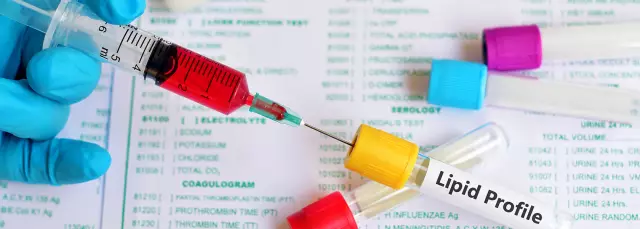- Author Curtis Blomfield [email protected].
- Public 2023-12-16 20:44.
- Last modified 2025-01-23 17:01.
In the blood plasma of any person, you can always find total cholesterol, triglycerides, phospholipids, as well as one or more specific proteins inherent in each particular organism. Among this list, many are concerned, of course, with cholesterol, which, in fact, makes up the lipid spectrum of the blood. Doctors divide it into lipoproteins of different density levels (high, low and very low). In terms of chemical structure, lipoproteins are protein-fat compounds that can dissolve in water and consist of cholesterol, proteins and phospholipids.
What are lipoproteins of different density levels?

A person should be afraid of very low density lipoproteins that the liver produces, they are the ones that can causeatherosclerosis. Low-density lipoproteins account for approximately 60 to 70 percent of total total cholesterol. This group of lipoproteins can cause various cardiovascular diseases. But they are not so bad, they, like transport, carry lipids in the peripheral blood. The most useful are high-density lipoproteins, it is they who stand guard over the body and protect it from the development of atherosclerosis. These lipoproteins transport cholesterol from the tissues back to the liver, where it is then formed into bile. The higher this fraction of lipoproteins, the less likely a person is to develop atherosclerosis.
Pay attention

The blood lipid spectrum, which should be directly monitored, includes low and high density lipoproteins. It is from their balance that the degree of risk of developing diseases of the heart and blood vessels depends. After all, if there is more cholesterol, it is worth fighting with it. But do not be zealous, because this is also a useful substance that is consumed by the body for the construction of cell membranes, bile is produced from it, which helps break down fats. Surprisingly, hormones, steroid and sex, are synthesized from cholesterol. That is why it is important to control the lipid spectrum and monitor the ratio of different groups of lipoproteins.
When should I get tested?
It is worth thinking about donating blood if you develop symptoms of atherosclerosis, diseases associated with the heart, such as coronary disease or a heart attack. And also when there are problems with the liver andkidneys, endocrine diseases such as diabetes mellitus or an underactive thyroid gland. Deciphering the lipid spectrum becomes possible when donating blood, from which plasma is then extracted. It is she who will tell about the ratio of "good" and "bad" lipoproteins in humans.
Blood should be taken on an empty stomach, at least 14 hours must have passed since the last meal. A day before the proposed study, it is better to completely abandon fats in the diet, then the analysis will be carried out much more accurately. You can drink tea, juice, but tobacco will have to be abandoned for a while.
Finding the norm

Having received an analysis in your hands, it is worth interpreting it correctly, and a specialist can do it. But even a simple layman himself can deftly figure out the answer received from the laboratory. If it says that high-density lipoproteins are elevated, and low and very low are within the normal range, then you should be glad that just such an analysis was given: the lipid spectrum in it is simply in perfect condition. If low-density lipoproteins have gone beyond the lower limits of the norm, then, most likely, the transport function of lipids in the body is impaired. But if the indicator of low and very low density lipoproteins exceeds the figure of 3.37 mmol / l, then you should not wait, the risk of developing atherosclerosis is quite high, and you need to wage a merciless fight against it.
An increase in lipoproteins can be a serious cause of coronary heart disease, especially if this indicatorcrossed the mark of 4, 14 mmol / l. A cardiologist will help reduce atherogenic factors and thereby align the lipid spectrum. The norms of various fractions of cholesterol may vary depending on gender and age, and in each period of life they are different. This is also taken into account by the doctor when making a diagnosis and prescribing treatment.
Proper nutrition

An important factor that affects the lipid spectrum of blood plasma is nutrition. It is on what a person is that the predominance of certain lipoproteins depends. Of course, it is worth absorbing fats, the body cannot live without them, and problems can arise at the hormonal level, but in nutrition, as in any other business, the most important thing is not to overdo it. Food is a burden on the body, and periodically it should be given rest. A fasting day can become such a rest, it is very useful when the body receives only vegetables and fruits, as well as freshly squeezed juices throughout the day. It is best to do such days no more than once a week, during the fasting day the body will be able to use up its own cholesterol reserves.
Prevention can't hurt
You can check your lipid spectrum just like that, for the purpose of prevention. In this case, it will become known for certain whether it is worth worrying about the risk of developing atherosclerosis or not. The doctor prescribes the analysis, but the patient himself, by contacting a private laboratory, can pass it without much difficulty. But for interpretation and help, it is best to contact a specialist and get a professionalconsultation.






